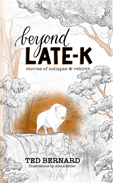
 |
Beyond Late-K: Stories of Collapse and Rebirth
by Ted Bernard; Alexa Miller (illustrator)
Petra Books
Informed by Ted Bernard’s nonfiction about sustainability in American communities, this connected collection of stories is a sequel to his first novel, Late-K Lunacy. Late-K refers to how complex, interconnected ecological and economic systems such as our late-stage capitalistic societies can become inflexible and collapse.
Set in the Ohio Valley, the ten stories begin in 2020 in an alternative scenario in which the Covid-19 pandemic is much worse than in reality. Soon followed by a second pandemic, nuclear disaster, and social upheaval, the world is left in ruin, with few survivors. The stories follow several key characters through the decades leading up to 2060, as survivors rebuild their tiny communities without the benefit of nearly forgotten modern technology in a pre-industrial scenario bereft of humanity’s usual natural fertility and ability to easily bear children. Bernard’s character-driven storytelling is reminiscent of Margaret Atwood’s MaddAddam trilogy, also an excursion into dystopian speculative fiction in a literary context.
Bernard handles male and female and alternative-gendered characters equally well, with a perceptive eye toward the strengths and weaknesses of all. Mostly, his primary characters possess a strong work ethic and an inborn wisdom that is needed for their embrace of a world with just a partial skeleton of the previous political and social structure. The southern Ohio communities of the stories are naturally multidimensional and multicultural, with the egalitarian tendencies one would expect of most humans when physical survival is enhanced by cooperative behavior in a post-carbon world. There are pirates and abusive people, but those who choose to take advantage of others’ vulnerabilities don’t necessarily thrive as some criminals and grifters do prior to societal collapse.
Though Bernard has drawn the social and physical environments that he’s familiar with into his fiction, readers will see many parallels in how their own communities could be reduced by a collapse and yet still survive. There are no colorful Hunger Games dramas or quirky, human-like species to emulate in Bernard’s universe, but there is a myriad of small but plausible power plays and tragedies marking the lives of his uber-believable characters that readers will understand and relate to.
The tale begins in Canada circa 2012-2021 as the life of a daughter of Egyptian immigrants marries a man who eventually transfers with his company to a job in South Carolina. The husband/father commutes back and forth to Canada, but life soon begins to crumble due to the Covid-19 pandemic. Safiya Kamal ends up far from home with her two small daughters as they try to see Safiya’s ex-husband (and the girls’ father) as he lies dying in a South Carolina hospital. Thus begins a story that will come full circle as Salma, one of the girls, and her mother end up as key figures in later stories set in the Ohio River Valley after Safiya and her daughters try but fail to make it home to Ottawa by bus. The second tale, set in 2030, also follows a key character aptly named Hestia, after a Greek goddess, a woman interconnected in a myriad of ways with many female and male characters throughout the progression of stories.
At first, the progression of stories and characters is a bit confusing, but with some patience, readers will follow the plot threads detailing the evolution and transformation of key characters and their interactions (and sometimes their deaths) in descriptive and well-considered prose and dialogue. This isn’t a book that will please genre readers who prefer more simplicity in written style. Readers will work harder to follow Bernard’s intellectual drift and evocative writing but will be rewarded ultimately with a commendable, well-rounded, and complex tale in what sadly could end up being humanity’s destiny in the near future as the Earth teeters on the edge of ecological disaster.
RECOMMENDED by the US Review